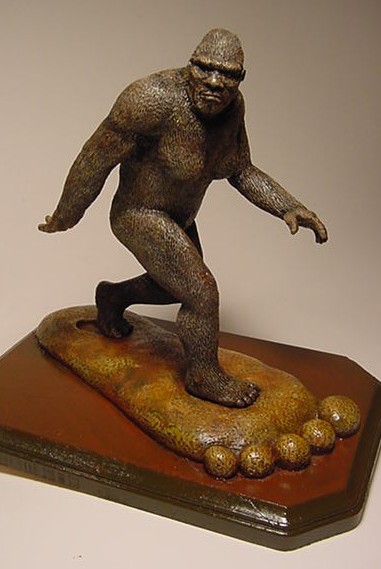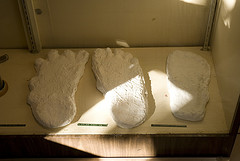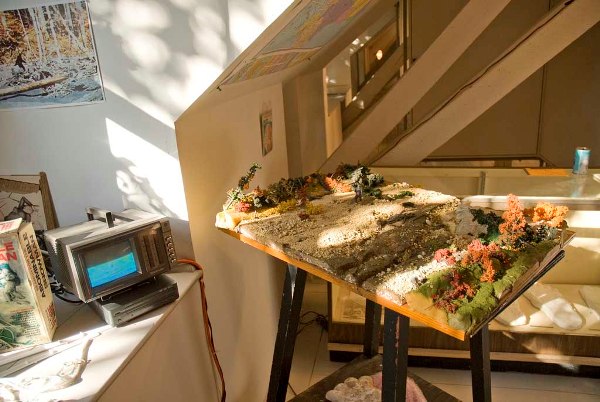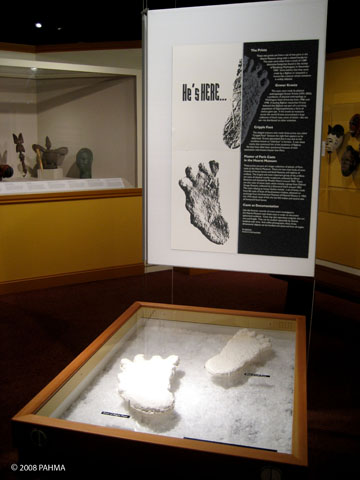
October 8, 2008

I’m always adding new items to the museum. The Bigfoot collectibles, like Jeff H. Johnson’s sculpture of the Patterson-Gimlin Bigfoot (above), outnumber all the rest. Johnson’s art is one such object, a resin model, and not exactly a toy.
So, how does one pick and choose? How about some public opinion here on what is appreciated in museums?
What do you like to see in exhibition cases when you visit your neighborhood cryptozoology and Bigfoot museum?
Over the weekend, I drove up to the Center for Contemporary Art in Rockport, Maine to pick up a donation from installation artist Tyler McPhee.
Tyler McPhee was breaking down his exhibit recreating part of a Bigfoot museum. This involved moving along two display cases he had recycled himself from the anthropology museum at the University of Maine in Orono. He passed them on to me for the International Cryptozoology Museum, if I would come and pick them up. With the assistance of museum volunteer Jeff Meuse and my son Caleb doing all the heavy lifting at this end, the huge cases were moved into my Portland location last Sunday.
Now, how to utilize them? Of the hundreds of items I have to choose from, what should I place in the cases? And how to make the displays presentable before the film crew from MonsterQuest arrives at my door the middle of next week?

McPhee’s use of this display case involved showing photos of Yeti images at one end, and here, at the right end, the Bossburg casts and another one attributed to Roger Patterson.

You can see the hint of one of the Rockport display cases behind McPhee’s “In Search Of” model of the Patterson-Gimlin footage scene shoot at Bluff Creek.
Some uses of display cases can be quite nice, especially in well-funded institutions. Just take a look at what the Phoebe Hearst Museum of Anthropology, Berkeley, California, did with a short (February 8th-29th, 2008) exhibit of two Bigfoot casts, which had been donated by Grover Krantz to their collection. These happen to be the same two Bossburg casts shown in McPhee’s display above.

What the Berkeley museum, as well as the exhibition “Cryptozoology Out of Time Place Scale” shown at Bates College’s Museum of Art and Kansas City’s Art Institute (as shown below) had going for them were flat display cases, lots of space, and money. (All items displayed are from my collection.)
For display cases that have more height than depth or width, it sometimes looks rather strange to have only long flat footcasts in tall cabinets (without thinking about other objects in the case).
Above and below is Bigfoot historian Al Hodgson at the Willow Creek – China Flats Museum in northern California. You can see that museum has some tall display cases. (Photos: Paul Vella/Jerry Riedel & Bigfoot Museum)
At the 2006 Bigfoot exhibition at the University of Texas San Antonio’s Institute of Texan Cultures, some casts from Craig Woolheater collection were placed in long, wide cases (as shown below) and and others’ objects in a couple taller clear ones viewable from all sides filled with stone carvings, skull replicas, and busts.
I am standing next to the long line of Texas’ display of Bigfoot casts.

Photo courtesy of Chris Buntenbah
At the Bates College exhibition, the curators had one central taller display case with larger items in it. The case was a great way to show all sides of the skull models and artist Dick Kylver’s bronze of Patty (below), which, once again, are items from my collection.
The McPhee donated-cases are tall with viewing through the front and top. What would you put in them? How would you set up the new cases? With one theme? A mix? I am interested in your ideas.
What have you enjoyed in the past at Bigfoot museums? Or wished you would see in the future (other than, of course, the actual body of a Bigfoot/Sasquatch on exhibition)?
This is your chance to sound off on what you would like to see on display in a Bigfoot or cryptozoology exhibit. What are your choices for the two new glass museum cases at the Portland, Maine museum?
Thank you.
+++++
Sign up today for “Bene-Foot: The Comedy Benefit…” coming November 22nd.
About Loren Coleman
Loren Coleman is one of the world’s leading cryptozoologists, some say “the” leading living cryptozoologist. Certainly, he is acknowledged as the current living American researcher and writer who has most popularized cryptozoology in the late 20th and early 21st centuries.
Starting his fieldwork and investigations in 1960, after traveling and trekking extensively in pursuit of cryptozoological mysteries, Coleman began writing to share his experiences in 1969. An honorary member of Ivan T. Sanderson’s Society for the Investigation of the Unexplained in the 1970s, Coleman has been bestowed with similar honorary memberships of the North Idaho College Cryptozoology Club in 1983, and in subsequent years, that of the British Columbia Scientific Cryptozoology Club, CryptoSafari International, and other international organizations. He was also a Life Member and Benefactor of the International Society of Cryptozoology (now-defunct).
Loren Coleman’s daily blog, as a member of the Cryptomundo Team, served as an ongoing avenue of communication for the ever-growing body of cryptozoo news from 2005 through 2013. He returned as an infrequent contributor beginning Halloween week of 2015.
Coleman is the founder in 2003, and current director of the International Cryptozoology Museum in Portland, Maine.
Filed under Artifacts, Bigfoot, Breaking News, Cryptomundo Exclusive, Cryptotourism, CryptoZoo News, Cryptozoologists, Cryptozoology, Footprint Evidence, Forensic Science, Hoaxes, Megafauna, Men in Cryptozoology, Museums, Photos, Pop Culture, Sasquatch, Windigo, Yeren, Yeti, Yowie